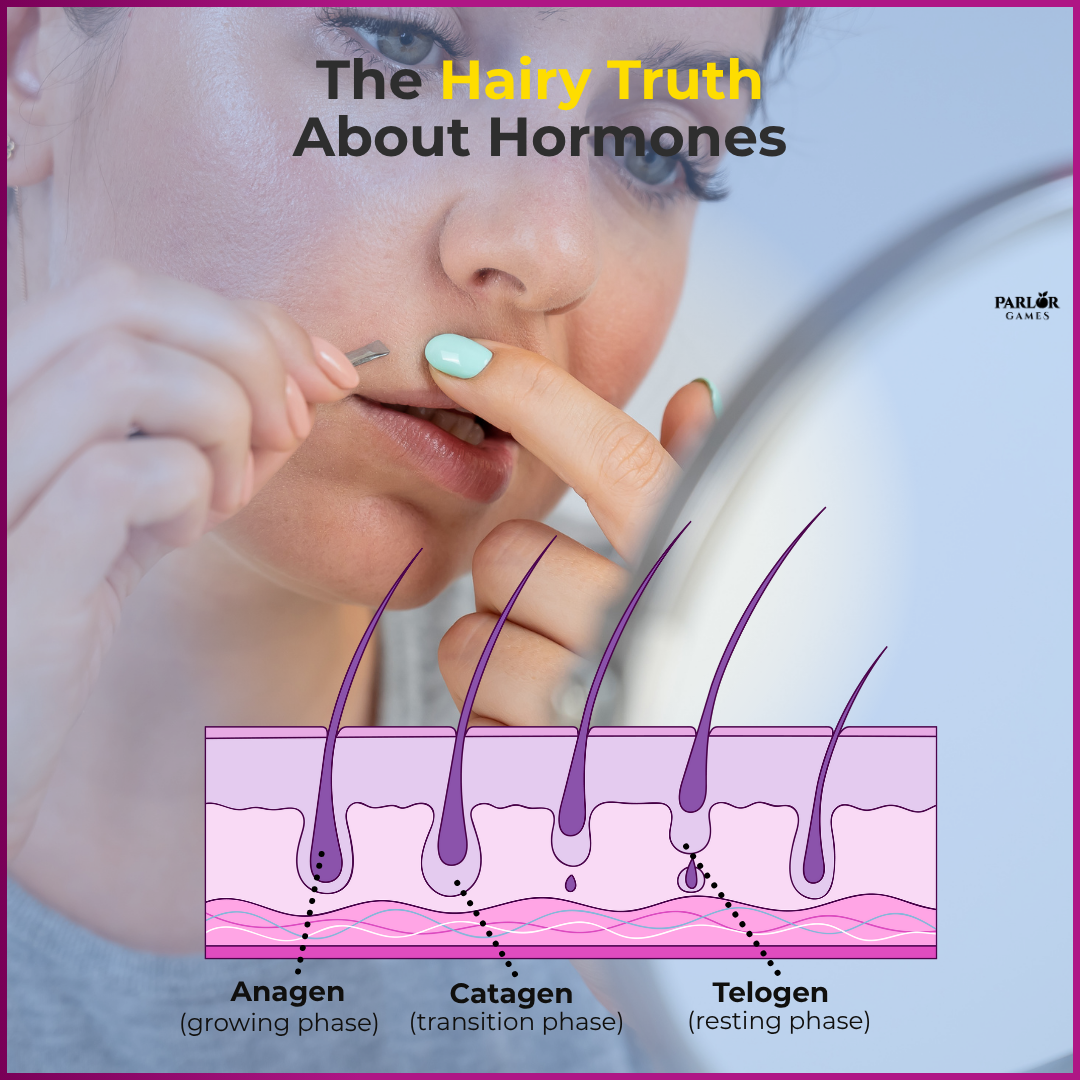LAST DAY TO SAVE 10%* - Coupon BFCM2024
*Excludes BioNude, subscriptions, hormone tests and health coaching

When it comes to menopause (and perimenopause), it can seem like the more hair we lose on our heads, the more we gain on our face.
We’ve written about hair loss in more detail, but today we’re diving into the equally maddening issue of facial growth — and most importantly, how to stop feeling like you’re morphing into your Uncle Larry.
Let’s break it down.
Here’s the short version: hormone shifts.
During perimenopause and menopause, your levels of estrogen and progesterone start to dip. Meanwhile, androgens like testosterone (which your body still makes) don’t fall as fast — so relatively speaking, you’re more “androgen dominant.”
This hormonal seesaw leads to two problems:
The medical name for this? Hirsutism — and it’s frustratingly common.
(The science of hair loss, from aging to hormones)
Hair growth is a cycle with three phases:
Hormonal imbalance — especially declining estrogen and progesterone — shortens the anagen phase and pushes more follicles into telogen, causing them to shed before they’re ready.
At the same time, increased androgen sensitivity (or excess androgens, especially DHT — dihydrotestosterone) shrinks the hair follicle. This causes finer, weaker hair, especially at the scalp.
Meanwhile, facial hair follicles often respond more enthusiastically to androgens, which is why chin hairs are suddenly sprouting with the confidence of a weed in summer.
And aging doesn’t help:
All these factors contribute to “bad hair days” that become “bad hair years.”
Unfortunately, hormones aren’t the only players in this hairy game. Here’s what can add fuel to the follicle fire:
And yes, some medications — like steroids, antidepressants, or hormone blockers — can make things worse.
Whether you're battling scalp loss or rogue chin hairs, here are science-backed strategies to support your strands:
When natural hormones decline, bioidentical hormone replacement therapy (BHRT) can restore balance — not just to mood, sleep, and energy, but also to your hair.
Estrogen supports the anagen (growth) phase and reduces androgen activity.
Progesterone also inhibits 5-alpha reductase — the enzyme that converts testosterone into DHT, the more aggressive form of androgen that miniaturizes hair follicles.
In other words:
Clinical studies suggest that topical or systemic BHRT may help reduce hair thinning, though results vary and work best alongside a comprehensive hair health plan.

Lorem ipsum dolor sit amet, consectetur adipiscing elit.
Lorem ipsum dolor sit amet, consectetur adipiscing elit.
Lorem ipsum dolor sit amet, consectetur adipiscing elit.
Lorem ipsum dolor sit amet, consectetur adipiscing elit.
Disclaimer: The information provided above is intended for educational and informational purposes only. Statements made have not been evaluated by the FDA nor are they intended to treat or diagnose. Any health concerns should be discussed and evaluated by your primary health care provider.
Parlor Games, LLC ● kate@parlor-games.com ● 5304 River Rd N Ste B ● Keizer OR 97303
Disclaimer: The information provided above is intended for educational and informational purposes only. Statements made have not been evaluated by the FDA nor are they intended to treat or diagnose. Any health concerns should be discussed and evaluated by your primary health care provider.
28 Day Challenge Subscription Details

We ship you a 28 day supply of Silky Peach Cream for only $29 (more than 25% off our normal price) when you sign up for Subscribe & Save.
Follow the directions we include in the package and apply Silky Peach cream on your tender bits for 28 days.

Decision Day:
5 days before your subscription rebills, we’ll send you an email reminder with a link. If you decide Silky Peach is nice but not your thing… you can click that link and cancel your subscription without even talking to anyone. No hassle — no questions asked.
If you are like 72% of our Silky Peach customers, you’ll love it and can't imagine life without it. In that case, do nothing, and we’ll welcome you to the Parlor Games family and ship Silky Peach Cream to your door step every month for the same discounted price of $29 — locked in for as long as you remain a subscriber.

Important note about our easy-breezy subscriptions:
We know that some companies make it hard to cancel a subscription — that’s not us. Our mission is to save the world — one vagina at a time! If you decide you don’t need Estriol as an ongoing solution for dryness, incontinence, UTIs and keeping sex fun and comfortable again, we understand. Five days before we ship your next order, you'll receive an email with a link to cancel right there in the message.
No hunting, no searching, we got you. Respect is where it’s at.
FYI – Estriol is beneficial for skin integrity and mucous membranes. It’s great for vaginal atrophy and also amazing for use on the face and neck. Applying a small amount — about 1 pump — can help build the collagen and plump up the cells to reduce wrinkles. Who knew!!
OUR HAPPINESS GUARANTEE
We want you to feel safe and confident trying any of our products. That's why we promise 100% money-back guarantee on the purchase price of the first bottle of any of our products. Balancing hormones DOES take some time, so please try it for 28 days. If after 28 days you are unhappy, or the product just hasn't worked for you, simply contact us and we'll process a refund of your full purchase price upon receipt. Sorry, shipping fees are not refundable.